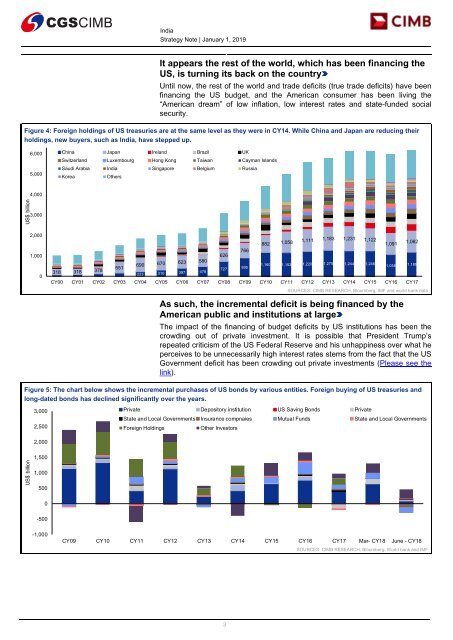Create successful ePaper yourself
Turn your PDF publications into a flip-book with our unique Google optimized e-Paper software.
Thursday, 3 January 2019 Page 1<br />
For important disclosures please refer to page 16.<br />
Christopher Wood christopher.wood@clsa.com +852 2600 8516<br />
Asset prices and the Fed<br />
Verbier<br />
How resilient is the American economy to monetary tightening? This is one of the questions posed<br />
in the new Asia Maxima quarterly (see Asia Maxima – Trade and tightening, 2 January 2019). GREED &<br />
fear’s base case has been that the American economy reverts to trend growth in 2019 following last<br />
year’s fiscally-driven acceleration. This would suggest a growth rate of 2.2%, which is the average<br />
growth rate since the recovery began in 2009 prior to the tax cut last year.<br />
Still the risk of an uglier outcome will rise if there is a nasty decline in asset prices. This is because in<br />
a post quantitative easing world, the normal causality taught in economic textbooks has reversed. By<br />
which GREED & fear means that asset prices now drive economies rather than the reverse.<br />
This has now become a highly-relevant point for investors, as asset prices declined last year as<br />
Federal Reserve quantitative tightening kicked in. The Fed’s balance sheet contracted by US$373bn<br />
in 2018 (see Figure 1). Investors should not assume this is a coincidence. For now at least the Fed’s<br />
quantitative tightening is set to continue at a pace of US$50bn a month, while the ECB confirmed in<br />
December it will stop quantitative easing from the end of 2018, even though the growth outlook in<br />
its region has deteriorated of late. Still, the ECB balance sheet will not shrink from its current size of<br />
€4.67tn, given that maturing bonds will continue to be reinvested.<br />
Figure 1<br />
Federal Reserve balance sheet contraction plan<br />
5.0<br />
4.5<br />
4.0<br />
3.5<br />
3.0<br />
2.5<br />
2.0<br />
1.5<br />
1.0<br />
0.5<br />
0.0<br />
(US$tn)<br />
Source: CLSA, Federal Reserve<br />
Other assets<br />
Agency debt & MBS<br />
Treasury securities<br />
Jan 07<br />
May 07<br />
Sep 07<br />
Jan 08<br />
May 08<br />
Sep 08<br />
Jan 09<br />
May 09<br />
Sep 09<br />
Jan 10<br />
May 10<br />
Sep 10<br />
Jan 11<br />
May 11<br />
Sep 11<br />
Jan 12<br />
May 12<br />
Sep 12<br />
Jan 13<br />
May 13<br />
Sep 13<br />
Jan 14<br />
May 14<br />
Sep 14<br />
Jan 15<br />
May 15<br />
Sep 15<br />
Jan 16<br />
May 16<br />
Sep 16<br />
Jan 17<br />
May 17<br />
Sep 17<br />
Jan 18<br />
May 18<br />
Sep 18<br />
Jan 19<br />
May 19<br />
Sep 19<br />
By contrast, the Fed’s balance sheet has already shrunk by US$396bn since September 2017, a<br />
decline of 9% since the balance-sheet contraction began in October 2017. At its peak, the balance<br />
sheet totalled US$4.5tn. If the Fed continues to shrink the balance sheet by the scheduled US$50bn<br />
a month during the coming year, it will have declined by a further 14.7% by the end of 2019.<br />
In such a context of accelerating tightening, credit spreads now need to be watched closely for signs<br />
of rising stress in the system. For they will be the signal of an uglier decline in asset prices than just<br />
a correction of stock market excesses, in terms of a derating of high PE growth stocks.
















